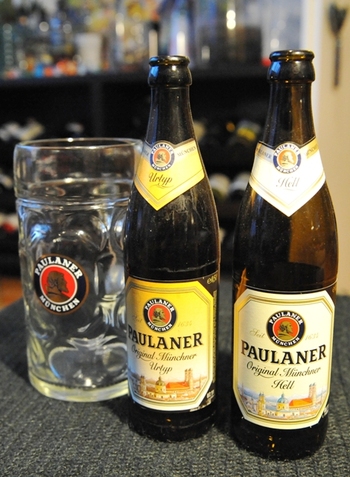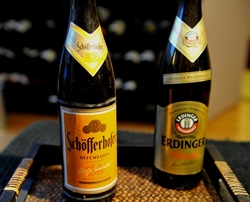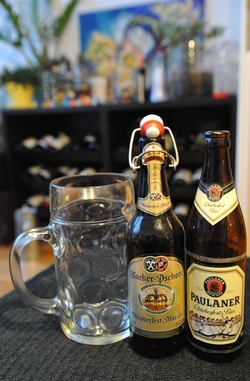German Beer Tournament - One Last Helles Round
 Wednesday, March 9, 2011 at 8:00
Wednesday, March 9, 2011 at 8:00 For the last of the Helles first rounds, we have Hofbräu Original vs Löwenbräu Original and Chiemseer Hell vs Augustiner Lagerbier Hell.
 We love Augustiner, especially at the beer gartens and restaurants. Augustiner restaurants are not as numerous as Paulaner and some of the other breweries, but you can always count on them having top quality food. So, we had high expectations of Augustiner in this tournament.
We love Augustiner, especially at the beer gartens and restaurants. Augustiner restaurants are not as numerous as Paulaner and some of the other breweries, but you can always count on them having top quality food. So, we had high expectations of Augustiner in this tournament.
Augustiner has been brewed in Munich since 1328, first brewed by the Augustinian monks, and now privately. Augustiner is notorious for putting quality above all else. Legend has it that when Munich's unusually hot summer led to the breweries running out of beer, Augustiner refused to brew extra beer through a shortened process (as did most other breweries) because they would not trade quality and process in order to sell more beer. Unfortunately, this also means Augustiner is somewhat difficult to find in the US. It is availalble in some places, but in limited quantities. In Texas, due to a dispute over labelling with the TABC, Augustiner decided that selling beer in TX was not worth changing anything.
Chiemseer was a beer we didn't know before. It looks and sounds a bit like Tegernseer, which is one of the top beers in the area. Unfortunately their website is down, so there isn't much info available.
While it would have been a tough climb for any beer opposing Augustiner, this was no contest. It's possible we got a bad bottle, but this beer just was not good. It tasted bitter - not a hoppy bitterness, but a bitterness with a slight chemical taste. So far, it's the one beer we've tasted that we can say we did not enjoy. I guess to be fair, we should try another one sometime, but we have so many other beers to taste that this will have to wait.
Then we have two of the most internationally known Munich beers - Hofbräu and Löwenbräu. Hofbräu, of course, is known more for the Hofbräuhaus and its Oktoberfest tent. Löwenbräu has brand recoginition as it shares the same name as a bad American beer.
According to its history, Hofbräu was founded in 1589 by Duke Wilhelm V because he was tired of the cost of importing beer and he did not like any of the Munich beers brewed at the time. Hard to imagine, as Augustiner and Weihenstephaner were around....but that's the official story.
Though the Löwenbräu name is not found on documents before the 1740's, there are references to a brewery going back to the late 14th century. It was one of the early pioneers among German beers in pushing for strong presence in the English-speaking markets abroad. I wasn't a beer drinker in the 70s and 80s, but supposedly it was very popular in the US. However, the reputation of American Löwenbräu I have always known was not as good beer...From the 70s until 2002, Miller brewed Löwenbräu under a licensing agreement and they included corn in the recipe, and I suspect different hops. However, today the Löwenbräu you'll find in the US is exported from Germany. After much consolidation in the beer industry, Löwenbräu is now the Spaten-Franziskaner-Löwenbräu Group, and part of InBev.
We weren't really sure which of these two we would prefer. I have to admit we both were a little prejudiced against both beers. Of course, they're pretty good beers in an absolute world, but in the world of Munich that includes Augustiner, Tegernseer, and wonderful weißbiers, they would not be our first choice. I actually put them in a first round match together in order to give them both an equal chance to advance.
These are two relatively similar beers, and surprisingly good. We found the Löwenbräu to have a crisper taste and the Hofbräu a little more hoppy, thus sent the Löwenbräu to the next round against Augustiner.
This is where the real shocker of the tournament comes...and proof that this is a blind tasting! Based on our beer garden experiences, there are few things better than sitting under the Augustinerkeller's chesnut trees in summer, drinking a cool helles. While the food and atmosphere at the Löwenbräukeller's little beer garden are among our favorites (their schnitzel is full of buttery goodness!), the beer is not great.
When we tasted the two together, it was very difficult to pick a winner. But the Löwenbräu was just a tiny bit tastier and it took out one of the tournament favorites!
 It makes me wonder....does Augustiner put their best beer in kegs for the beer gardens and Löwenbräu puts their best beer in bottles for sale???? Either way, Augustiner is still a great beer - one of my favorites here - and you really can't go wrong going to an Augustiner restaurant or beer garden.
It makes me wonder....does Augustiner put their best beer in kegs for the beer gardens and Löwenbräu puts their best beer in bottles for sale???? Either way, Augustiner is still a great beer - one of my favorites here - and you really can't go wrong going to an Augustiner restaurant or beer garden.
So it will be Löwenbrau vs Tegernseer in the contest to move on to the Elite Eight. I'm looking forward to that tasting!
 Frau A ...
Frau A ...  Post a Comment
Post a Comment  Beer,
Beer,  Germany & German Culture tagged
Germany & German Culture tagged  beer,
beer,  beer bracket,
beer bracket,  beer tournament ...
beer tournament ...  Print Article
Print Article  Email Article
Email Article 

























